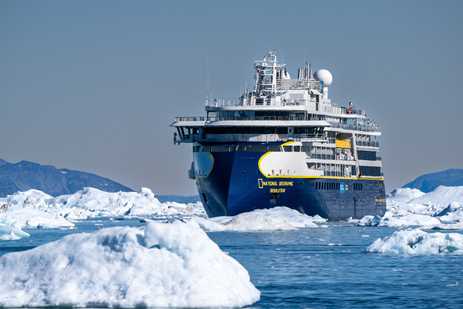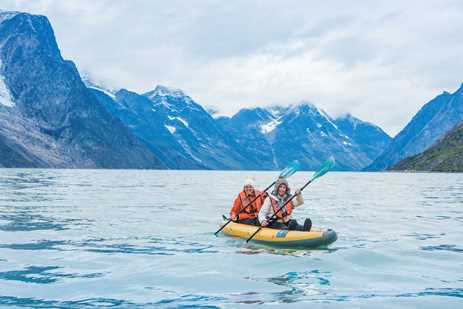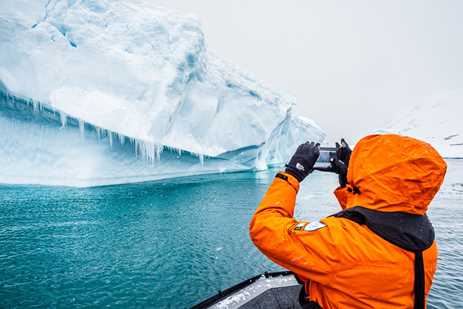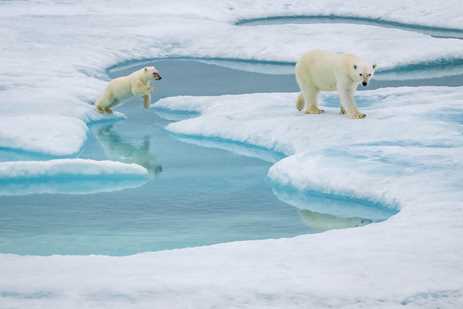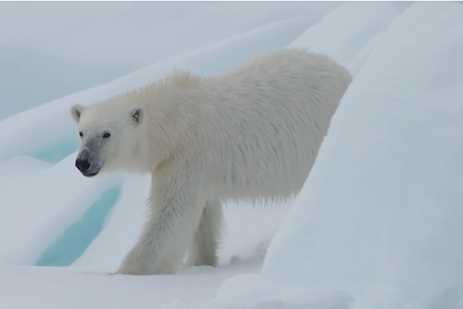Planning Your Voyage
Activities
What to Expect
Wildlife
Traveling to the Arctic: A Traveler's Guide
Stretching across the top of the globe, the Arctic is a vast and pristine region dominated by ice and ruled by wild creatures—a place that invites travelers to experience nature in its purest form. Here, the extreme environments speak a language of their own, telling stories of survival, adaptation, and the sheer force of nature.
Traveling to the Arctic demands preparation and a sense of adventure. In this guide, we'll navigate the essential preparations for an Arctic expedition, from understanding the unique climatic conditions to selecting the right gear and learning about the local wildlife and Indigenous cultures.
Why Visit the Arctic?
Traveling to the Arctic is a unique and extraordinary experience that promises a multitude of thrills for any adventurer. Here are some compelling reasons you should consider embarking on an Arctic adventure:
Unparalleled Natural Beauty: Arctic landscapes are unlike any other on Earth. An icy ocean surrounded by the coastlines of three continents, the scenery here is dominated by vast icebergs, advancing glaciers, and soaring fjords that together create an awe-inspiring spectacle of nature's grandeur. Witnessing the northern lights dance across the Arctic sky is also an unforgettable sight.
Wildlife Encounters: The Arctic is home to a variety of unique and resilient wildlife, including polar bears, reindeer, Arctic foxes, and countless bird species. Observing these creatures in their natural habitats is a rare privilege.
Cultural Immersion: Arctic communities have rich cultural traditions shaped by their extreme environment. Visiting these indigenous communities allows you to learn about their histories and traditions, providing you with a deeper understanding for how their way of life is linked to the land.
Active Adventures: From dog sledding and snowmobiling to ice climbing and sea kayaking, the Arctic offers a range of thrilling activities for adrenaline junkies and outdoor enthusiasts.
Unique Photography: The Arctic's ethereal light and pristine landscapes create a photographer's paradise, allowing you to capture breathtaking images that you can revisit for years to come.
What You Need to Know About Traveling to the Arctic Circle
The Arctic is a dynamic part of the world that changes noticeably from region to region and from month to month. If you are thinking about taking a trip to the far north, there are several factors you will want to consider in your planning, such as how you would like to travel, the time of year you want to visit, and what you need to pack for a safe and comfortable experience.
How to Get to the Arctic Circle
Accessing the Arctic Circle can be achieved through various means, including flights to northern countries such as Norway or Canada, which often serve as the embarkation points for Arctic expedition cruises.
Read more about How to Get to the Arctic Circle and Traveling to the North Pole
Luxury Cruise Options for the Arctic Circle
Luxury cruises offer a comfortable and comprehensive way to explore the Arctic. They typically include expert guides, comfortable accommodations, and the opportunity to witness a wide range of spectacular Arctic landscapes and wildlife.
Read more about Luxury Arctic Cruises and how to Explore the Arctic Circle in Comfort
Best Time to Visit the Arctic
The ideal time to visit the Arctic is during the summer months (June to August), when the weather is milder and the region is more accessible. However, for those wishing to see the northern lights, winter months are preferable.
Read more about When Is the Best Time to Visit the Arctic with A Month-by-Month Guide
What to Pack: Packing Checklist
Key items include thermal clothing, waterproof gear, sun protection, navigation tools, and emergency supplies. Always prioritize items that ensure your safety and comfort in harsh Arctic conditions.
Read more about What You Should Wear on an Arctic Trip
What's the Difference Between Antarctic and the Arctic?
The Arctic and Antarctic are polar opposites in terms of geography, climate, and wildlife. The Arctic is a northerly oceanic region surrounded by continents, while Antarctica is a continent at the bottom of the globe surrounded by ocean.
Read more about Antarctica vs. Arctic Expedition Cruises
Ideas for How to Explore the Arctic
Excursions in the Arctic may include guided tours, Arctic wildlife safaris, hiking expeditions, or cultural visits to indigenous communities, with each activity offering a unique perspective on the region. In most Arctic destinations, there is also the chance to experience the midnight sun in the summer months, or the northern lights after sunset during the shoulder and winter seasons.
Where to Go: North Pole
There are various options for traveling to the North Pole—the northernmost point on the planet. Embark on a budget or luxury cruise, ski across the frozen ocean, join a research expedition, or try a hot air balloon ride. These journeys promise unforgettable adventures, from epic wildlife encounters to breathtaking views.
Where to Go: Baffin Island
Baffin Island is home to roughly one-third of the population of Nunavut, Canada’s largest and northernmost territory. Many residents live in coastal Inuit communities, making Baffin Island an excellent place to experience High Arctic culture through experiences like traditional weaving and carving workshops. Outdoor adventure also abounds: travelers can kayak along the island’s rugged coastlines; go ice-climbing up towering cliffs; or hike the pristine landscapes of Auyuittuq National Park, known for its soaring peaks, steep fjords, and vast glaciers. Baffin’s waters and shores harbor iconic Arctic creatures like beluga whales and polar bears.
Where to Go: Spitsbergen
One of Europe’s most remote outposts, Spitsbergen is an island in the Svalbard archipelago, located mid-way between Norway and the North Pole. It’s one of the best destinations for viewing Arctic wildlife, with opportunities to spot everything from seals and walruses hauled out on the shorelines to herds of grazing caribou and majestic polar bears leaping across ice floes. Seek out these fascinating creatures on a guided hike, safari drive, or dog-sledding adventure. Or, take a cruise through stunning coastal fjords to witness massive icebergs and glistening glaciers. There are also opportunities to explore Spitsbergen’s fascinating frontier history with visits to museums and island settlements.
Where to Go: Greenland
Greenland, the world's largest island, is perhaps the quintessential Arctic destination, with a plethora of natural and cultural wonders emblematic of the far north. A massive ice cap covers most of the country, filling coastal fjords with glaciers that calve towering icebergs into the sea. Travelers can visit the world’s largest national park—Northeast Greenland National Park—for hiking or snowshoeing excursions across the tundra, or spy more than 15 species of whales in coastal waters. Discover the island’s cultural history at museums and archaeological sites or on visits to traditional Inuit settlements where ancient traditions and customs are celebrated.
Whale Watching in the Arctic
The Arctic is home to a variety of whale species, making whale-watching one of region’s most sought-after activities. The best time for these excursions is during the summer, when whales migrate to Arctic waters.
Read more about Arctic Whale Watching Cruises
Important Details You Should Consider While Traveling To The Arctic
When traveling to the Arctic, essential considerations include things like preparing for extreme weather conditions and planning for unique transportation challenges in this remote region. Additionally, cultural sensitivity and a willingness to adapt to local customs are crucial for a meaningful Arctic experience. Guidance on preparing for an Arctic expedition—including books and media with additional background information on the region—is provided below.
Weather and Seasons in The Arctic
The Arctic experiences extreme weather with cold temperatures, ranging from freezing to well below zero. It has two distinct seasons: an icy winter marked by continuous darkness and a short, cool summer when the sun barely sets. Weather conditions are highly unpredictable, making preparation and flexibility essential for Arctic travelers.
Read more about When Is the Best Time to Visit the Arctic with A Month-by-Month Guide
Arctic History
The Arctic has a rich history of exploration, indigenous cultures, and geopolitical significance. It's a region with stories that are as captivating as its landscapes. For a deeper understanding of Arctic history, delve into indigenous cultures like the Inuit, exploring their centuries-old traditions, art, and resilience in the harshest environments. On visits to museums and historic sites, discover the legacy of early Arctic explorers, such as Roald Amundsen and Robert Peary. Investigate the Cold War era's impact on Arctic territories where military bases and geopolitical tensions left a mark, and learn about the scientific polar expeditions that have unraveled some of the Arctic's many mysteries.
Books About The Arctic
Reading about the Arctic can provide valuable insights. The following books covering its history, exploration, and natural wonders are recommended for prospective travelers.
- Arctic Dreams by Barry Lopez
- The Last Viking: The Life of Roald Amundsen by Stephen R. Bown
- In the Kingdom of Ice: The Grand and Terrible Polar Voyage of the USS Jeannette by Hampton Sides
- Endurance: Shackleton's Incredible Voyage by Alfred Lansing
- The Ice Balloon: S.A. Andree and the Heroic Age of Arctic Exploration by Alec Wilkinson
- The Magnetic North: Notes from the Arctic Circle by Sara Wheeler
- The Call of Distant Mammoths: Why the Ice Age Mammals Disappeared by Peter D. Ward
- The Arctic: What Everyone Needs to Know by Klaus Dodds
- The Worst Journey in the World by Apsley Cherry-Garrard
- Ada Blackjack: A True Story of Survival in the Arctic by Jennifer Niven
Documentaries About The Arctic
The following documentaries offer visual journeys into the Arctic by showcasing its beauty and the challenges faced by its inhabitants and explorers.
- The White Planet (Documentary)
- Chasing Ice (Documentary)
- Nanook of the North (Silent Documentary)
- Arctic Tale (Documentary)
- The Farthest North (Documentary)
- Fortitude (TV Series)
- March of the Penguins (Documentary)
- Happy People: A Year in the Taiga (Documentary)
- The Terror (TV Series)
- The Revenant (Movie)
Arctic Transportation: Polar Cruising
You can visit the Arctic on an overland journey, traveling above the Arctic Circle in countries bisected by the boundary. But for a more encompassing experience, travelers can choose to explore the region by ship, which affords the opportunity to go between multiple regions quickly and efficiently and to discover remote and rugged shores that can’t be reached by road.
Choosing a polar cruise to the Arctic Circle is an exciting decision, but it requires careful consideration. Here are several factors to keep in mind when selecting the right cruise for your Arctic adventure:
- Destination and Itinerary: Determine which Arctic regions you wish to explore, whether it's Svalbard, Greenland, the Canadian Arctic, or elsewhere. Each Arctic region offers unique landscapes and wildlife.
- Duration: Consider the length of the cruise; shorter trips may focus on a specific region, while longer voyages allow for more extensive exploration.
- Time of Year: Arctic cruises are typically offered in the summer months when the ice is more navigable. Decide whether you prefer the midnight sun and milder temperatures of June to August or the northern lights and cooler weather in September.
- Cruise Type: Choose between expedition cruises, which prioritize exploration, and luxury cruises that offer more amenities and comfort.
- Cruise Line: Research different cruise operators and their reputations. Look for experienced companies with a strong commitment to environmental sustainability and safety.
- Vessel Size: Consider the size of the ship; smaller vessels can access narrower channels and offer a more intimate experience, while larger ones provide stability and more facilities.
- Activities and Excursions: Check the cruise's activity options, such as kayaking, hiking, and wildlife watching, to ensure they align with your interests.
- Wildlife Viewing: Determine the focus on wildlife encounters and the expertise of onboard naturalists and guides.
- Cabin Choices: Explore cabin categories, amenities, and comfort levels to match your preferences and budget.
- Safety Measures: Inquire about the ship's safety protocols, including emergency procedures and experienced crew members.
- Cost: Establish your budget, factoring in the cruise fare, flights, insurance, and additional expenses like excursions and gratuities.
- Pre- and Post-Cruise Options: Consider any pre- or post-cruise extensions that may enhance your overall Arctic experience.
- Travel Insurance: Purchase comprehensive travel insurance to cover potential trip disruptions due to weather or other unforeseen circumstances.
- Health Considerations: Ensure you are physically prepared for the trip, as Arctic cruises can involve challenging conditions and require a reasonable level of fitness.
- Environmental Responsibility: Choose a cruise operator committed to minimizing its environmental impact through sustainable practices.
- Reviews and Recommendations: Seek out reviews from previous passengers and gather recommendations from trusted sources to get a sense of what to expect.
- Travel Restrictions: Stay updated on any travel restrictions or entry requirements for the Arctic destination you plan to visit, especially in light of evolving international regulations.
Taking the time to carefully evaluate these factors will help you select the perfect Arctic cruise that aligns with your interests, preferences, and expectations, ensuring an unforgettable adventure to the remote and breathtaking landscapes of the Arctic Circle.
Read more about How Much Does It Actually Cost to Go to the Arctic and North Pole
Final Thoughts on Traveling to the Arctic Circle on a Cruise
The Arctic Circle is a vast region brimming with unique beauty—a place where glaciers gleam, polar bears roam, and the northern lights dance across the sky. It's a destination that beckons those who seek remote, pristine landscapes and the raw, untouched wilderness of the polar north.
On an expedition cruise through this unique and fragile region, you can immerse yourself in its history, culture, and wildlife; take time to appreciate the profound connection between humans and nature; and consider how we can all contribute to its preservation. So, set sail, embrace the Arctic's wonders, and create memories that will last a lifetime in this frozen paradise.





